|
|
|
|
.
Historic "L" Station Tour 2002
|
|
|
|
.
Historic "L" Station Tour 2002
|
The 4th Annual Historic "L" Station Tour, presented by Chicago-L.org, occurred Sunday, October 20, 2002. This was the fourth year the tour was conducted. Graham Garfield of Chicago-L.org and architectural historian John Craib-Cox, guides from the previous years' tours, returned for the fourth year to lead the tour, provide lectures, and answer participants' questions.
The fourth annual tour explored different lines from last year, focusing primarily on historic stations on the stations of the city's North Side. These included stops on the Loop, Brown Line (Ravenswood), Red Line (Howard/North Side Main Line), and Purple Line (Evanston). Stops on the Yellow Line (Skokie Swift) and in the State Street Subway portion of the Red Line, included in early stages of planning, had to be nixed due to issues concerning time allotment and equipment usage. Still, a varying mix of stations were explored, providing examples of many different vintages, types, architectural styles, and community locations.
The tour began with a welcome and historical overview at the historic, restored Quincy station Outer Loop platform. Participants then boarded the charter train and proceeded around the Outer Loop to Tower 18 and then northbound on the Brown Line. The first stop was Diversey station on the Brown Line. The group disembarked to view this excellent example of 1900-vintage Northwestern Elevated Italianate architecture, as well as the historic streetscape outside the station. Some of the elements discussed included the design and materials used in the station in comparison to those of surrounding buildings on the street, some of the interesting design features of the station's interior and exterior, and the history of the railroad at that location.
The next station on the tour was Dempster on the Purple Line. Here, passengers went downstairs and outside to view the small Georgian Revival station house from the vantage point of Sherman Place in front of the station. Again, the station was viewed in context with the surrounding commercial district and in addition to calling attention to the architectural design and materials, the compatible scale and massing of the station as compared to the rest of the surrounding buildings was pointed out. With 10 minute service on the Purple Line, there ought to have been plenty of time to view the small station and hear plenty of commentary. Unfortunately, the spacing of the road trains was not correct and the charter's in-service follower caught up with it sooner than it should have. The stop cut short by several minutes, the group hustled back up stairs to head to the end of the Purple Line.
The tour-takers enjoyed the trip, which provided many unique looks at Chicago rapid transit history. Chicago-L.org would like to extend special thanks to the Chicago Transit Authority, Rail Operations management personnel Linda Lee and John Blum for helping to schedule the charter, Rail supervisor Cory Fowler for helping the trip to go smoothly on the railroad, and all the participating employees who were very cooperative, helpful, and flexible, helping to make the tour the success that it was. Without the CTA's® assistance, little of this would have been possible. |
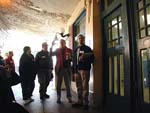 |
tour02@Jarvis01.jpg (137k) The stone and brick Prairie School features of Jarvis station provide the guides with ample discussion material on the second stop of the station tour. (Photo by Tony Coppoletta) |
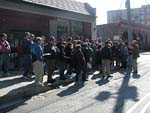 |
tour02@Dempster02.jpg (168k) The group is assembled across the street from the Dempster station on the Purple Line to hear about the station's design. This location provides not only an excellent place from which to view the station, but also a vantage point for the surrounding buildings, which share a common scale and massing. (Photo by Tony Coppoletta) |
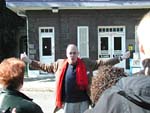 |
tour02@Dempster03.jpg (154k) Guide John Craib-Cox visually demonstrates concepts of sizes, scale, and massing to the group in front of the Dempster station. (Photo by Tony Coppoletta) |
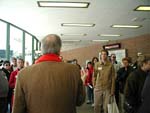 |
tour02@Linden01.jpg (108k) Before proceeding to the historic station at Linden, the guides discuss the form and design of the current, modern brick, steel and glass station building, providing a source of comparison and contrast for the historic structure. (Photo by Tony Coppoletta) |
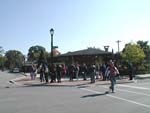 |
tour02@Linden04.jpg (106k) The tour group is in front of the historic Prairie School Linden station, which is adjacent to the current facility and which now houses a bank. The location not only is excellent to view the historic station but also the surrounding corner of 4th and Linden avenues, which has many other historic, ornate buildings. (Photo by Tony Coppoletta) |
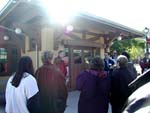 |
tour02@Linden06.jpg (112k) Information about Linden station's design, architecture, modifications over the years, and subsequent adaptive reuse and historic restoration is provided to the group by the tour's guides, Graham Garfield (right, in blue CTA® jacket) and John Craib-Cox (left, with red scarf). (Photo by Tony Coppoletta) |
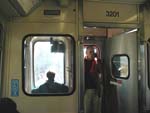 |
tour02b.jpg (105k) Guide John Craib-Cox provides historical and architectural information about passing buildings and elements over the PA system as the train proceeds to its next tour stop. (Photo by Tony Coppoletta) |
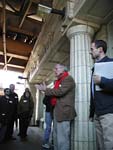 |
tour02@SouthBlvd02.jpg (145k) The fluted Doric pillar of Beaux-Arts South Blvd. station provides the backdrop of Guide John Craib-Cox's discussion of the station's architectural design and building materials as tour members attentively listen. (Photo by Tony Coppoletta) |
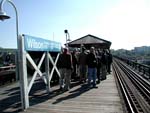 |
tour02@Wilson02.jpg (136k) The north end of the wide Red Line platform at Wilson provides an excellent vantage point from which to view the station complex and discuss its history and development. It also provides a view of the historic peaked canopy (in background) and some of the last incandescent gooseneck light fixtures on the system located at the outer ends of this station. (Photo by Tony Coppoletta) |
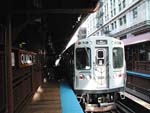 |
tour02@Quincy01.jpg (146k) At the conclusion of the tour, the charter train returned to historic Quincy station, where the tour had started over four hours before. There, participants disembarked the train, but were free to remain to view the station or ask additional questions of guide Graham Garfield. (Photo by Tony Coppoletta) |
 |
2002flyer.pdf
(116k) |
 |
handout02.pdf
(1.2MB) |
|
|